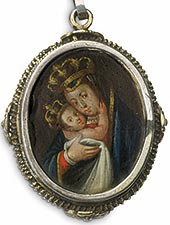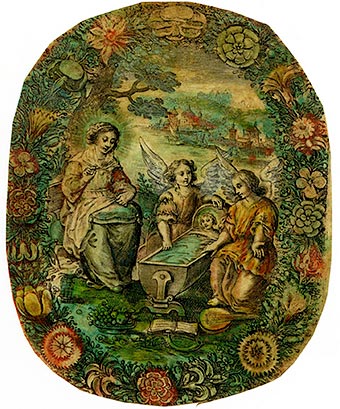18/12/2020
Published in
Diario de Navarra
Ricardo Fernández Gracia
Director of the Chair of Navarrese Heritage and Art
The so-called sumptuary arts were not alien to Christmas, as one would expect, a fortiori, since they were often objects related to daily life in the different social strata. Silverware and embroidery, we will leave for another occasion, taking into account their importance.
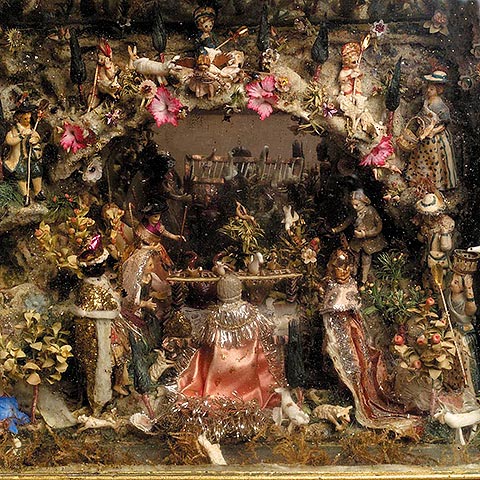
Detail of the window with nativity scene of the Capuchinas de Tudela.
A whole set of pieces included in what we call sumptuary arts and made up of engravings, enamels and jewelry constitute, to this day, very important materials for the reconstruction of history, not only of the images and their iconography, but of human behavior, mentalities, religiosity and popular traditions, while they tell us about their own uses and functions. In all these pieces converge very diverse values: art, religiosity, Economics, politics ... etc. The programs of study and the interest in these small objects have grown in the last decades and the works in specialized magazines and their presence in public and private collections are a good testimony of it. All this interesting heritage, preserved in private collections and in ethnographic museums or museums of popular arts and traditions, has not been properly exhibited and studied until today and it is really worthwhile to raise awareness in our society, increasingly distant from the religious phenomenon, of the values of these small pieces as authentic cultural assets.
Medals, measures, scapulars, gozos and engravings are part of a set of objects that people required to possess, see and touch something related to a spiritual dimension of the set of abstract and immaterial principles that regulate the relationship between man and the Divinity. These pieces allowed a more intense and intimate connection between the aforementioned binomial, as well as being genuine witnesses of the daily religious internship of several generations, of their feelings and devotions.
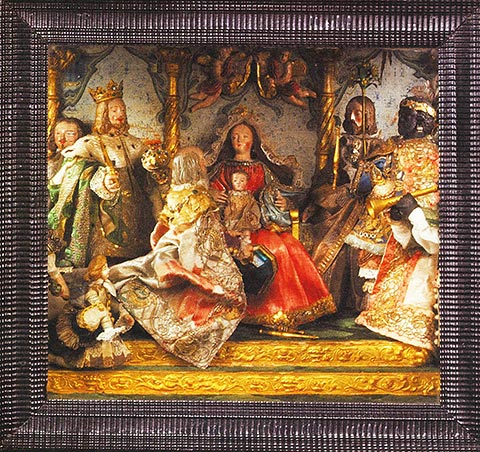
Epiphany Showcase in Recoletas de Pamplona, 1731.
Jewelry with Christmas content made of different materials
The ornament staff was no stranger to Christmas motifs. In different places in Navarre some important pieces are preserved, both for their use and function as well as for their artistic category. They are, in general, medallions of different sizes and shapes with stained glass windows and frames of silver, gold or other materials, carved with more or less ornaments or plain. Most of them contain paintings on vellum, parchment, copper or paper or miniature enamels and in some cases small sculptures.
An exceptional piece is a rectangular medallion of the Augustinian Recollect Nuns of Pamplona, like a small silver box in its color, with a cord of the same material and a central part in half point with a crossed handle. In its interior there is a Baby Jesus lying down, with one of his hands on his face. The medallion must have been part of an arracada of those that women wore for their adornment staff attached to the waist and, in this case, with a clear function of protection in the months of pregnancy. It is possible that it can be identified with some of the jewels collected by the chronicler Antonio Villerino in his work of 1690, when in dealing with some miracles of the Virgin of the Wonders, he refers to that of the wife of a lawyer of Pamplona, who was cured of childbirth and tabardillo, for which her relatives donated for the trousseau of the mentioned image a rosary of pearls, choker and braid and a cord "and other toys.... for the Child she has on her arm, which is one of the most beautiful I have ever seen".
Several medallions are framed in different materials and show another topic very much to the Christmas taste, which is the Virgin of Bethlehem, in her well-known iconography of a half bust embracing the Child Jesus and both characters wearing royal crowns. These are copies of the picture painted in 1662 by Francisco Camilo for a chapel of the convent of Antón Martín in Madrid, praised by Palomino and reproduced as if it were an icon, in different paintings and engravings. Many of its images spread thanks to the Franciscan influence, which celebrated with profusion the mystery of Christmas. In Spain the "Virgin of Bethlehem" was chosen in 1688 as patroness of the Royal Congregation of Architecture. She was also patroness of the Congregation of hermits of the Sierra de Córdoba.
Another unique medallion from the beginning of the 18th century, in this case in gold and with the representation of the Epiphany in Spanish school enamel, was on display at exhibition A Belén pastores, (Pamplona, 2006-2007). At the same sample , another 19th century Nativity and the Three Wise Men's parade pinjante was exhibited, in this case made with cut ivory plaques, from the Arrese Foundation of Corella.
|
|
|
|
|||
|
Medallion from the end of the 17th century |
Gold medallion with enamel |
||||
|
|
|||||
|
Child in Recoletas in its baroque silver case |
Antwerp illuminated vellum with the angels and the Virgin watching over the sleeping baby Jesus. Private Collection |
||||
Convent craft showcases
An interesting chapter of the nativity scene art is constituted by a series of handicrafts from the Navarrese cloisters destined to protectors and donors. These are the so-called showcases, defined in 1732 by the Diccionario de Autoridades as "jewels made in the manner of a storehouse with its doors and shelves inside to keep jewels, fine mud and other delicate things, which women use a lot in their rooms to keep their charms", formed an inseparable and singular part of the Hispanic noble interiors . This is reflected in 1690 by the Baroness de Aulnoy in her Relation d'un voyage en Espagne, who enthusiastically describes the Spanish showcases as "a kind of cabinet Closed with a large crystal and full of everything that is possible to imagine of rarest" being these "the most beautiful thing I have found there [in Spain]".
The Augustinian Recollect Nuns of Pamplona keep with care and great appreciation some of them. In 1731, they would invent: "two ebony showcases with their crystals on three sides, in one is the Adoration of the Kings and in the other the Flight into Egypt". In the same year, among the goods of Teresa Sos, mother of Don Fermín de Lubián, future prior of the cathedral of Pamplona, "a crib in its drawer" is noted.
Arrese points out that at the end of the XVIII century and part of the following century a singular craft flourished in the convent of Araceli de Carmelitas Descalzas of which curious examples are still preserved and which consisted in the construction of these small showcases, normally in the form of a box that contained in its interior, visible through a glass in the front part, different themes composed of polychrome figures of clay or wax. In them the nuns refined their hands with silks, pieces of spurs and silver filigree. Four are preserved in the Museum of the house of Arrese, among which deserves special accredited specialization one dedicated to the Nativity in a greenish glass urn in the shape of a bell.
The Capuchin nuns of Tudela kept a couple of curious showcases, where it is difficult to locate the figures themselves, due to the abundance of small animals and flowers that speak of the horror vacui that characterizes this subject of works. The nuns made these small sets, elaborated with mixed techniques, based on clay figures, bread crumbs, paper, cardboard, fish scales, gold and colored metal sheets, waxes and rich fabrics.
The interest of these reductions lies in the fact that they translate, frequently and in a faithful way, the way of placing the great figures in the nativity scenes at that time, being the case of many that are authentic historical testimonies, because the figures and the complete nativity scenes have disappeared.
From medieval miniatures to small engraved and illuminated prints
Among the miniatures are the representations in two outstanding codices, in the Bible of Sancho el Fuerte (1197) and in the Breviary of 1332 of the cathedral of Pamplona. This manuscript belongs to the time of Bishop Barbazán, and is considered as the oldest liturgical guide of the diocese and of the cathedral of Pamplona, where Christmas is recorded as part of the Most Excellent or Insignes feasts, together with Easter, Pentecost and the Assumption of the Virgin. These feasts are equivalent to what in later centuries were the double festivities of the first class, with six-layer ceremonial.
In the centuries of the Modern Age, with the diffusion of the techniques of mechanical multiplication of images, we find Christmas themes in different objects such as engravings, medals (minted in Rome for the great sanctuaries since the 16th century), reproductions in clay, lead, silver and wax. All this was an excellent means for the diffusion of numerous devotions. But it was undoubtedly engraving that was most significant in the process of propagation of images. Between the 15th and 19th centuries, engravings were the primary means of disseminating both images and ideas. Their multiple character is their most genuine distinctive feature. Since there was no single copy, what was sought was that there should be many identical reproductions from a matrix.
Vellum prints came mostly from Flanders and particularly from the city of Antwerp. Also the illumination of the engravings gained then an unusual vigor, arriving in Spain in enormous quantities as much from France, as from the Low Countries, throughout the centuries of the Baroque. Albert in an unpublished work points out: "These engravings constituted by the delicacy of the drawing and the attractiveness of the coloring, the pieces of luxury destined to people of position and artistic Education ". Of the French imports there are numerous news, as for those that arrived from the Netherlands, the data are more reduced, although the issue of conserved pieces speaks of as many as the French ones. In 1655 some merchants agreed with a couple the sale of prints from those lands, among them: "thirteen thousand pieces in octavo and quarto of different saints and saints... and other one thousand five hundred of vellum of Boutats ....".
On many occasions they were framed with rich craftsmanship and on other occasions they became part, as bookmarks, of the prayer books and breviaries of various people, both in the cloister and outside it. Some represent the Holy Family, others the Child Jesus in the cradle or triumphant with the cross and over the skull and the serpent (death and sin), others the Virgin with the Child and Saint John the Baptist, others the Adoration of the shepherds, the Epiphany, and some even reproduce compositions famous in Flanders with a large border of flowers as a large garland and a specific topic as the Virgin and the angels watching over the sleep of the Child Jesus.
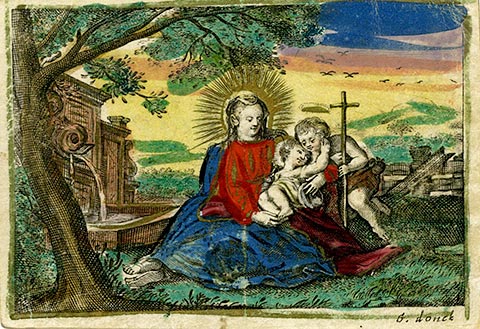
Madonna and Child with St. Johnny on illuminated vellum by G. Donck. Private Collection

